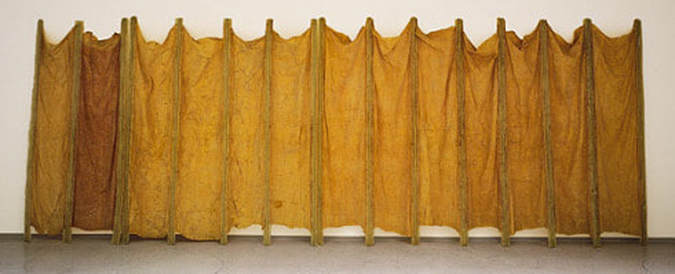|
Expanded Expansion
Once there was a curtain, between the holy and the holy of holies, a divide between you, and by the time you finish this sentence, me; a cheesecloth screen such as might appear in an operating theatre of the skull, beautiful and thin, like the soft, insecure skin of Saoirse Ronan. Suspended between fibreglass poles, thirteen diaphanous actresses - Astrid Bergès-Frisbey, Amanda Seyfried, et cetera - raising between the living and dead a short-lived skene, a prophylactic contraceptive against dread - that benign expansion of the mind into timelessness - and a screen behind which to undress unseen underneath Sarah Gadon's shadow projected against quarantine tent walls, her contours expanding then shrinking, creating illusions of distance between quick and quickless that cannot exist, like empty pyramids, full of darkness, naked flames, and no Pharaoh, just Elle Fanning, laid out by the fire, warm embers, a little light; Thirteen lengths of hand-flayed skin, borrowed from Alicia Vikander to lampshade horror's brilliant filaments, her tattoos shadow puppets thrown around the room. Each exit being commensurate with that of Kristen Stewart, who from the Maloja Pass vanished outright, who am I to roll out snake-like clouds to curtain certainty? Or who to clothe the elderly actress who is presently debarking as Stacy Martin? A sculptor, whose materials - youth and beauty - are not chosen for their strength or durability - there is nothing young about stone or bronze, and nothing living about those illusions, those chiselled apologies, graven tautologies; Roomfuls of Pharaohs and copper serpents. Ella Purnell behind a sudden motel shower curtain. The latter foreshadowed by the former's lack. And you, you will visit the synagogue, one kristallnacht, to withdraw the scroll of the law from the holy ark and you will find it torn. And after its fulfilment the rituals will go on, the priest-curators, recalling the old koans, restoring worship, turning prophecy to paradox “Jerusalem, Jerusalem, killer of the prophets” in sheepskins, goatskins, Chloë Grace Moretz. Skeleton of brittle sticks, and bandages slung between limb after limb, scavengers closing heavily in, thumping their wings and blustering sand, in the desert wind barely stands, pressed and wrung, Odessa Young. Or leaning, propped against a wall, between crutches, Adele Exarchopoulos; the weakening structures that roam through hospices, cancer wards, and halfway homes, are left hobbled, locked away like prophets who talked us into feeling too ashamed; locked away and only ever rolled out during earthquakes, typically the girl’s body swapped with an imposter’s, a plastic mannequin, or an immortal spirit, instead of Mia Wasikowska. Exegesis My poem aims to describe the sculpture ‘Expanded Expansion’ by Eva Hesse. Hesse’s sculpture, which originally resembled a clean, white shower curtain, consists of thirteen lengths of latex-covered cheesecloth hung between brittle fiberglass sticks reinforced with resin. More than half a century after its creation, the ‘curtain’ now looks more like an ancient scroll or parchment. The piece was included as part of a 1969 exhibit at the Whitney called ‘Anti-Illusion: Process/Materials’. Hesse’s artwork was ‘anti-illusion’ in the sense that it defied the fantasy of immortality typically pursued by sculptors employing more durable materials, such as stone or bronze. While such sculptors might hope to achieve immortality through their work, Hesse aimed to create a work that would realistically reflect her mortality, of which she was more than ordinarily aware, having already developed the brain tumour that would soon kill her. My poem approaches Hesse’s sculpture simultaneously from several different angles, but most conspicuously through the naming of contemporary actresses. Debates about the use of pop-culture references in serious literature have often centred around their lack of durability as reference points. My pop-culture references are specifically chosen for their transience. The actresses named in my poem are not the subject of my poem but the materials, chosen for their youth, beauty, and lack of durability. If the poem is successful, the reader encountering these names will experience a sense of the poem’s mortality, and easily foresee a time when the poem’s exact effect will become worn, decayed, and fragmentary. My use of Sapphic stanzas reinforces this through its association with Sappho, whose poems have come down to us mostly in fragments. I chose actresses (rather than male actors, for example, or singers) because of their acute susceptibility to ageing, in an industry and culture that perceives them as disposable, once their looks begin to ‘fade.’ As such, they are representative of a more immediate mortality than are the majority of people. Joel Martyr Joel Martyr studied at Deakin University in Melbourne, Australia. His work has previously been published in The Explicator and on his website Fork’s Pass Poetry. He currently lives with his wife in Bristol, United Kingdom, where he teaches high school English.
1 Comment
Joel Matar
5/17/2021 12:16:54 am
Hey, that's pretty good.
Reply
Your comment will be posted after it is approved.
Leave a Reply. |
The Ekphrastic Review
COOKIES/PRIVACY
This site uses cookies to deliver your best navigation experience this time and next. Continuing here means you consent to cookies. Thank you. Join us on Facebook:
July 2024
|




